
Reference Publication: Sonne, J., Vieira., Rudd, A., "Limiting Solar Radiation Effects on Outdoor Air Temperature Measurement" ASHRAE Transactions: Research. Disclaimer: The views and opinions expressed in this article are solely those of the authors and are not intended to represent the views and opinions of the Florida Solar Energy Center. |
Limiting
Solar Radiation Effects on
Outdoor Air Temperature Measurement
Jeffrey
K. Sonne, Robin K. Vieira and Armin F. Rudd
Florida
Solar Energy Center (FSEC)
FSEC-PF-240-92
ABSTRACT
This experimental study compares various methods of reducing the effects of solar radiation on outdoor air temperature measurements. It indicates that radiation effects can introduce signfi cant measurement error, even with the use of shielding devices and aspiration, and outlines efforts that were taken to lessen the error caused by radiation.
Two separate tests were conducted, one comparing naturally ventilated and fan-aspirated radiation shields, the other comparing seven identical fan-aspirated shields. Results from the first test showed that one of the naturally ventilated shields was generally more effective than a fan- aspirated unit—at some instances of high radiation giving daytime temperatures as much as 0.7°F (0.4°C) lower. Attaching foil-faced insulation to the cylinders of the fan- aspirated unit generally reversed the results, making the fan unit usually give the lowest temperatures by as much as 1.3°F (0.7°C). Results from the second test showed that the temperatures recorded using seven identical fan-aspirated shields differed by as much as 0.7°F (0.4°C) in morning and afternoon sun but consistently less than 0.2 °F (0.1°C) during non-sun hours.
INTRODUCTION
Limiting the effects of daytime direct beam and diffuse solar radiation and nighttime long-wave radiation is important if accurate outdoor air temperatures are required. The authors are beginning to conduct work on the potential of urbanization to alter outdoor ambient temperature. in their study, meteorological measurements will be used to experimentally compare three different sites:
- an undeveloped wooded site,
- a well-treed, shaded residential development, and
- an unshaded residential development.
Air temperature differences are expected to be small, on the order of 2.0°F (1.1°C); thus accurate measurements are important. Although a 2.0°F (1.1°C) difference may seem insignificant, it can add as much as 2% onto an electric utility’s peak summer load (Akbari et al. 1989).
Since the unshaded site will be exposed to considerably more radiation than the shaded site, any effect of radiation on the measurements could considerably bias the results.
Two experiments designed to quantify the effects of radiation on outdoor air temperature measurements were conducted over a six-month period and are reported in this paper. The objective of the first experiment was to ascertain the effectiveness of naturally ventilated radiation shields compared with fan-aspirated shields. One commercially available fan-aspirated shield was compared with two different naturally ventilated shields. Testing the naturally ventilated shields was important because the undeveloped site did not have electric power readily available. Based on conclusions drawn from the first experiment, a decision was made to purchase seven fan-aspirated radiation shields. The second experiment compared the seven identical fan- aspirated shields alongside the shields used in the first experiment. A discussion of various methods used to reduce the observed radiation effect on the seven otherwise identical units is given.
COMPARISON OF NATURALLY VENTILATED AND FAN-ASPIRATED RADIATION SHIELDS
Experimental Plan
 |
Figure
1. Experimental configuration for comparing fan-aspirated unit (left), pyramid unit (center), and gill-plated unit (above right). |
The experimental setup for comparing the radiation shields is shown in Figure 1. The shields were mounted approximately 8 feet (2.4 meters) from the ground on a 10- foot (3.1-meter) test stand in an open area. Care was taken to ensure that all three units were exposed to equal radiation (i.e., not shaded by the test stand or each other) and were in close proximity to one another. Measurements were taken by datalogger every 15 seconds and averaged over 15-minute periods.
One shield was a commercially available fan-aspirated unit using a triple-wall aluminum cylinder as the actual sensor housing. The second was a commercially available, naturally ventilated gill-plate shield and the third a naturally ventilated unit especially designed and constructed on site for this comparison. It differed from the gill-plate unit in that it was substantially larger and pyramid shaped, using louvers on the outside walls for ventilation. The idea behind this design was to keep the sensor as far as possible from the walls receiving the radiation and to increase ventilation.
Figure
2.
Fifteen-minute averaged temperatures for three aspiration units,
4/14/91.

Results
Nighttime data showed that in the absence of solar radiation, measured temperature differences between the three thermocouples were consistently less than 0.5°F (0.3°C). Daytime results, however, showed much greater differences of up to 2.9°F (1.6°C) under high solar radiation conditions of 200 to 320 BtuI(h/ft2) (631 to 1010 W/m2). Figure 2 is a graph of a typical 24-hour period of the 50 days data were collected showing temperature differences between the three units; the corresponding solar radiation levels are shown in Figure 3. The gill-plate naturally ventilated shield generally gave the lowest daytime temperatures, the fan-aspirated unit the next lowest, and the pyramid unit the highest. Table 1 shows averaged temperatures for the date shown for all three units. Notice also that during the nighttime hours the pyramid unit, which had the greatest sky view, recorded the lowest temperatures. This result showed that the pyramid unit had the greatest radiation-based temperature error. In order to account for any possible thermocouple and/or datalogger bias, the sensors in the two naturally ventilated units were switched at one point, but no significant changes in results were found.
Figure
3.
Corresponding horizontal solar radiation for temperature data in
Figure 2.

TABLE
1.
Average Air Temperature Comparison for Three Shields 4/14/91
Average
Temperature °F (°C) |
|||
Time
Period |
Fan
Asp. |
Pyramid |
Gill
Plate |
12
mid. to 6 a.m. |
73.7
(23.2) |
73.5
(23.1) |
73.7
(23.2) |
6
a.m. to 9 a.m. |
75.5
(24.2) |
75.8
(24.4) |
75.6
(24.2) |
9
a.m. to 3 p.m. |
79.0
(26.1) |
79.7
(26.5) |
78.6
(25.9) |
3
p.m. to 6 p.m. |
78.1
(25.6) |
78.5
(25.8) |
77.9
(25.5) |
6
p.m. to 12 mid. |
74.6
(23.7) |
74.4
(23.6) |
74.5
(23.6) |
In an attempt to improve the performance of the fan- aspirated shield, foil-faced insulation was wrapped around the unit. This wrap was installed on both the vertical sensor housing cylinder and the horizontal cylinder between the fan unit and the sensor for the last 24 days of data collection. The insulation improved the performance of the fan unit to the point where it generally gave the lowest daytime readings, with as much as a 1.3°F (0.7°C) difference between it and the gill-plate unit and as much as a 3.2°F (1.8°C) difference between it and the pyramid unit. Figure 4 and Table 2 show typical daily data recorded with the insulation in place; Figure 5 gives the corresponding horizontal solar radiation for the day.
Figure
4.
Fifteen-minute averaged temperatures for three
aspiration units 5/11/91; fan unit with foil/insulation batt.

Figure
5.
Corresponding horizontal solar radiation for temperature data in
Figure 4.

TABLE
2.
Average Air Temperature Comparison for Three Shields 5/11/91
- Fan-Aspirated
Unit with Foil/Insulation Batt
Average
Temperature °F (°C) |
|||
Time
Period |
Fan
Asp. |
Pyramid |
Gill
Plate |
12
mid. to 6 a.m. |
75.4
(24.1) |
75.0
(23.9) |
75.4
(24.1) |
6
a.m. to 9 a.m. |
77.7
(25.4) |
78.6
(25.9) |
78.4
(25.8) |
9
a.m. to 3 p.m. |
81.1
(27.3) |
82.9
(28.3) |
81.5
(27.5) |
3
p.m. to 6 p.m. |
80.6
(27.0) |
81.7
(27.6) |
81.0
(27.2) |
6
p.m. to 12 mid. |
76.8
(24.9) |
76.6
(24.8) |
76.8
(24.9) |
Figure
6a.
Gill-plate temperature minus fan-aspirated temperature (°F)
and wind speed (mph) vs. time: lower wind speeds.
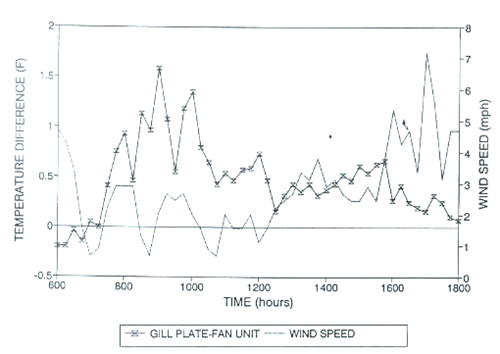
Figure
6b.
Gill-plate temperature minus fan-aspirated temperature (°C)
and wind speed (m/s) vs. time: lower wind speeds.
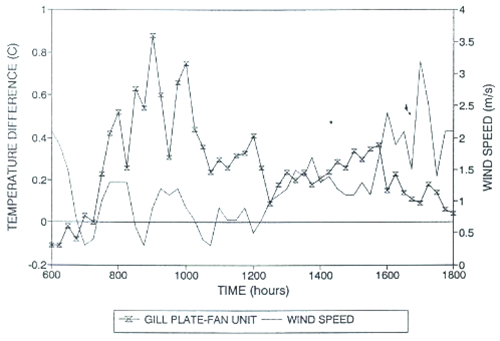
During this comparison test, wind speed data were also collected to determine to what extent the naturally ventilated units were dependent on wind speed. Temperature differences between the fan-aspirated and gill-plate naturally ventilated shields were plotted along with wind speed for two days with varying wind speeds. Figure 6 shows that some of the greatest temperature differences occurred at wind speeds of less than 2.2 mph (1.0 mIs). Conversely, Figure 7 represents a day with consistently higher wind speeds, mostly above 6.6 mph (3 ni’s), and shows greatly reduced temperature differences. Solar radiation levels for both days used in this comparison weie very similar. These results confirmed that, for naturally ventilated radiation shields, ambient wind speed can have a significant effect on measurement accuracy.
Figure
7a.
Gill-plate temperature minus fan-aspirated temperature (°F)
and wind speed (mph) vs. time: higher wind speeds.
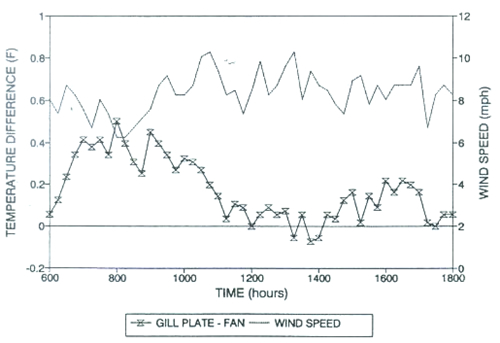
Figure
7b.
Gill-plate temperature minus fan-aspirated temperature (°C)
and wind speed (m/s) vs. time: higher wind speeds.
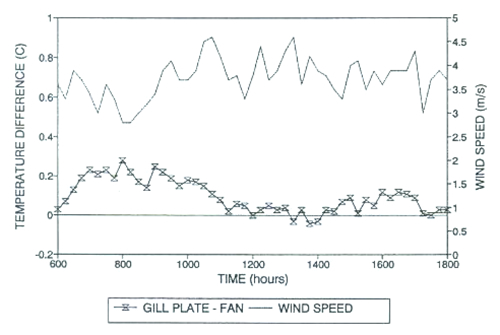
COMPARISON OF OUTDOOR AIR TEMPERATURE USING SEVEN IDENTICAL FAN-ASPIRATED SHIELDS
Experimental Plan
Having determined that a well-designed fan-aspirated shield could be more consistently effective than a naturally ventilated shield, the next task was to find a more effective fan-aspirated shield, that is, one that did not require insulation added on site. A unit was chosen that the manufacturer specified to limit the effects of radiation to 0.05°F (0.03 °C) under a maximum solar radiation of 354 Btulh/ft2 (1117 W1m2). For this experiment, a new set of nine thermocouples was used.
Again all thermocouples were calibrated at ice point, 77°F (25°C), and at 104°F (40°C) in water baths. The thermocouples were subsequently recalibrated while in their shields on the outdoor test stand. The new calibration values gave smaller temperature differences than the original and so were used exclusively in the comparisons.
 |
Figure
8. View from the southeast of experimental configuration for comparing seven identical fan-aspirated units. Foil-wrapped fan-aspirated unit of different type is shown on right. Gill-plated unit is out of view. |
Figure 8 shows the physical setup with the seven new fan-aspirated shields used in this test along with the gill- plate shield and original foil/insulation-wrapped fan-aspirated unit. The new fan-aspirated shields used an aluminum triple-wall-cylinder sensor housing but also included two round shields above the housing in between which the fan was mounted. Six of the new shields were mounted off a north-south axis, three on each side, so that three units would be partially shaded by the other three in the morning and vice versa in the afternoon. This configuration would help exaggerate morning and afternoon radiation effects. The other unit was mounted to the north of the stand and was not shaded by the structure or other units.
Results
Data collected showed nighttime temperature differences between the seven shielded thermocouples to be almost always less than 0.2°F (0.1°C). However, daytime data showed temperature differences of up to 0.7°F (0.4°C), as can be seen in Figure 9. Data also showed that thermocouples in the shields that were unshaded to the east generally gave higher temperatures in the morning as the sun was rising and directly striking the cylindrical sensor housing. Figure 10 shows temperature differences between one thermocouple, clt3, on the west side and the other six. The three thermocouples on the east side do give higher morning and lower afternoon temperatures than the three thermocouples on the west side, showing a definite radiation effect up to 0.4°F (0.22°C) greater than the manufacturer’s specification of 0.05°F (0.03°C).
Figure
9.
Maximum absolute temperature difference between
any two of the seven identically fan-aspirated thermocouples.

Figure
10.
Measured temperature differences of
thermocouples in seven identical fan-aspirated units.

The thermocouple temperatures in the seven units were also compared to the fan-aspirated and gill-plate units from the first experiment. Figure 11 compares the daytime measurements of the highest of the seven units, c2t2, with the two other shield types because that would present the best- case scenario. The gill-plate unit was consistently higher than the other two units. On average, from 600 to 1800 hours for the two days shown, the temperature of the gill-plate unit was 84.20°F (29.00°C), and the two fan-assisted units were an identical 83.52°F (28.62°C), giving an average temperature difference of 0.68°F (0.38°C). Figure 12 shows corresponding solar radiation and wind speed for the data in Figures 9 through 11.
Figure
11.
Temperatures for thermocouples housed in three different shields.

Figure
12a.
Solar radiation (Btu/h/ft2) and wind speed (mph) during experiment.
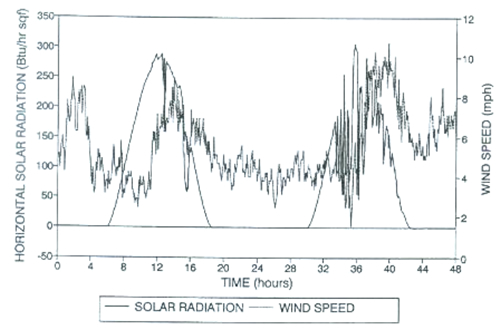
Figure
12b.
Solar radiation (W/m2) and wind speed (m/s) during experiment.
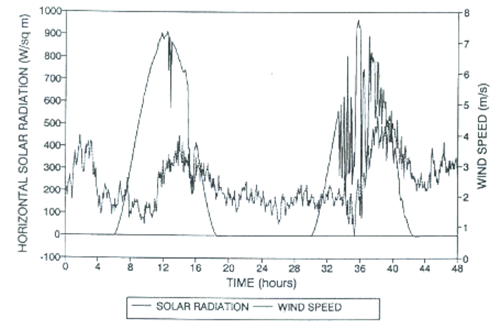
The radiation effect on thermocouple measurements was an order of magnitude larger than the manufacturer claimed. Because the addition of foil insulation worked well for the original fan-aspirated unit, a similar strategy was attempted on the identical units. Foil-faced insulation was wrapped around three of the units; however, no noticeable difference in temperature measurements occurred.
The insulation wrap was removed and a foil skirt was placed approximately 8 in. (20.3 cm) away from the cylinder of each unit to block early morning and late afternoon sun. Temperature differences increased slightly, indicating the skirts failed to provide the desired result.
DISCUSSION
Due to the influence of wind speed on temperatures measured in the naturally vented gill-plate unit, it was determined not to be reliable enough for the purpose of the authors, as wind speed will probably vary significantly between sites (Heisler 1989). Where less accuracy is acceptable and/or more equal wind speeds are expected, the naturally ventilated unit should be adequate.
The authors are still completing work to try to quanti1r the maximum effect of radiation on the seven identical units but will soon begin an experiment to determine the error associated as a function of radiation and sun angle.
Anothermethod of determining radiation effects has been suggested (ASHRAE 1989). This method uses different gauge thermocouples inside the same enclosure. Radiation between the thermocouple wire and the shield varies with wire diameter. The true temperature is determined by extrapolating to zero diameter. Unfortunately, some of the radiation effect may be convected into the airstream from the inside of the triple-wall cylinder and would not be accounted for using this method. This method also requires more datalogger input channels, which are limited due to expense.
CONCLUSION
Solar radiation can have a significant effect on outdoor air temperature measurements even when utilizing radiation shields. The results reported in this paper make no claim as to how accurate shielded temperature measurements are in absolute terms but are reported in terms of temperature differences. The major conclusions from comparisons of four different radiation shield designs are as follows:
- A commercially available, naturally ventilated gill-plate shield outperformed a prototype, louvered, naturally ventilated, pyramid-shaped shield.
- The naturally ventilated gill-plate shield performed as well or better than one commercially available fan-aspirated shield as it came from the manufacturer.
- By wrapping the cylinder of the fan-aspirated unit with foil-faced insulation, the unit was generally able to outperform the gill-plate shield. This indicated that the fan-aspirated shield could benefit from better engineering design.
- The temperature difference between thermocouples housed in the gill-plate unit and the foil/insulation-wrapped, fan-aspirated unit was larger during times of low wind speed and smaller during times of high wind speed under identical solar radiation, showing that naturally ventilated shields cannot be relied on as consistently as properly designed fan-aspirated shields.
- Maximum differences among thermocouples housed in seven identical fan-aspirated shields were 0.2°F (0.1°C) at night but as much as 0.7°F (0.4°C) during the daytime. The manufacturer’s specifications claimed radiation effects no greater than 0.05°F (003°C).
- Attempts to reduce the radiation effects on the air temperature measurements by applying insulation and reflective devices were unsuccessful for the seven identical shields.
ACKNOWLEDGMENTS
The authors would like to express their appreciation to the Florida Energy Office (FEO) for funding of the project for which this study was conducted, FSEC staff members Danny Parker and Philip Fairey III for technical assistance, and Wanda Dutton for word-processing help.
REFERENCES
Akbari, H., R. Rosenfeld, and H. Taha. 1989. Recent developments in heat island studies: Technical and policy. LBL-27872, Controlling Summer Heat Islands, p. 15.
ASHRAE. 1989. 1989ASHRAE handbook—Fundamentals, p. 137. AUanta. American Society of Heating, Reffigerating and Air-Conditioning Engineers, Inc.
Heisler, G.M. 1989. Mean windspeed below building height in residential neighborhoods. LBL-27 872, Controlling Summer Heat Islands.
